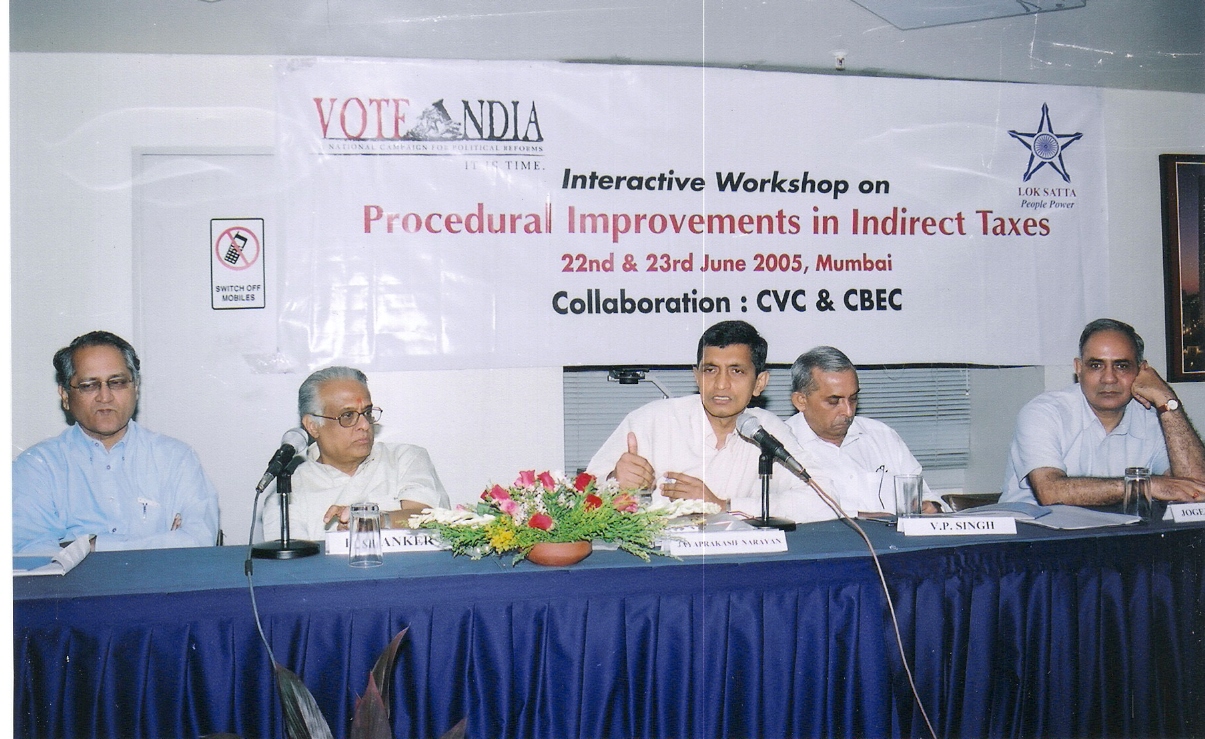| Indirect
Tax Reforms Initiatives.. |
Letter
from Dr.JP : 
Dear
friends,
You may
recall the initiative of the Central Vigilence Commission for improving
procedures in indirect taxes administration. Lok Satta hosted two
successful workshops in Mumbai and Hyderabad in 2005 with CVC, CBEC,
Industry, experts and civil society representatives. Precise and actionable
recommendations emerged from these workshops. Sri P Shankar, the Chief
Vigilence Commissioner, now sent us a report of CBEC indicating the
action taken on these reform proposals.
Please
read my reply to CVC and the table indicating the action taken. Both
are self-explanatory.
These
documents can be accessed from below:
With
warm regards,
Jayaprakash
Narayan
Procedural
Improvements in Indirect Taxes
Good
for the goose, good for the gander
First-of-its-kind initiative for reforming indirect taxes holds promise
for both government and the industry
| Small
and medium enterprises are subjected to enormous harassment and
extortion in the name of tax administration. Vast amounts of time
and energy is wasted dealing with such problems, which invariably
affects production, productivity and competitivenes s. Improvement
of tax administration alone could boost the economic growth rate
of India by about one percent per annum. This is why VOTEINDIA
has launched the nation-wide campaign for Procedural Improvements
in Indirect Taxes, under the banner 'Plucking feathers without
hissing', in the spirit of Jean Colbert. |
|
Formally
launched in Hyderabad and Mumbai in June 2005, this campaign for
bringing transparent and industry-friendly reforms in 'Central
Excise and Customs' has been taken up in collaboration with the
Central Vigilance Commission (CVC) and the Central Board of Excise
and Customs (CBEC). The campaign will endeavour to simplify taxation
procedures, reduce arbitrariness and unbridled discretion in order
to minimize corruption, while enhancing the effectiveness of the
Customs and Central Excise departments. Chief Vigilance Commissioner
P. Shankar, who inaugurated the event, encouraged the participants
to make full use of this unique opportunity to generate worthwhile
solutions to the existing challenges in indirect taxation procedures.
The workshops witnessed open and cordial deliberations between
the industry and the CBEC officials, with participation from taxation
experts and the civil society. These deliberations saw the evolution
of genuine consensus among participants and a 'can-do' sense of
optimism among the CBEC officials, on key proposals and reform
measures specific to streamlining the CBEC organization and structure,
enhancing accountability, and simplifying excise and customs procedures.
Lok Satta had drafted these recommendations on CVC's suggestion.
Once implemented, these recommendations would result in simple
and transparent procedures, improved trust between department
and industry, encouragement for voluntary compliance, improved
accountability and reduced litigation, better service quality
to the industry while enhancing the position and image of the
department. The CBEC has already taken tangible steps in this
direction. |
 |
Reforming
procedures in tax administration is an extremely complex task,
even in the best of circumstances. But when these taxes are the
biggest revenue earners for the government, such a reform becomes
all the more difficult. But any such reforms would, greatly benefit
the industry too. For when it comes to reforming procedures in
indirect taxes, what's good for the goose is most certainly good
for the gander. |
| |
|
|
Indirect
Taxes: A Primer
- Broadly
speaking, taxes are of two kinds: direct and indirect. Direct
taxes are levied on the incomes of individuals and corporations.
Salaried employees and entrepreneurs, are familiar with income
and corporate taxes, which constitute most of the direct taxes
collected by the union government. Indirect taxes are levied
on goods and services and are mostly made up of excise and
customs duties, sales tax or VAT.
- Of
the total tax received by the union government, around 62%
comes from indirect taxes and the rest from direct taxes (Source:
Reserve Bank of India). Until the advent of economic liberalization,
this figure used to be well over 70-75%.
- Until
the nineties, our country used to have a highly irrational
and even counterproductive direct taxation system. Under this
system, the tax rates were very high and not surprisingly,
tax evasion too was staggeringly high. But, over the past
fifteen years, the tax rates have been rationalized and tax
laws and procedures have been simplified to significant extent.
This resulted in better compliance and a consistent increase
in the direct taxes collected by the Indian Union
- Though
a similar effort has been made to reform the indirect taxation
tariff structure, full benefits are not realized because procedural
bottlenecks and excessive discretion still remain. These difficulties
create a sense of harassment among the industries. They also
adversely affect the competitiveness of our industry in the
global market and thereby, affecting economic and job growth
in our country. Indirect taxation procedural bull has not
been grabbed by its horns. Not until now, at least.
|
|



